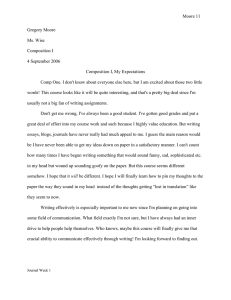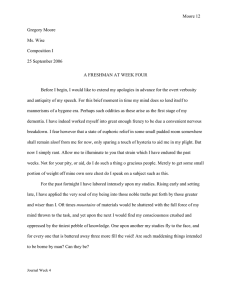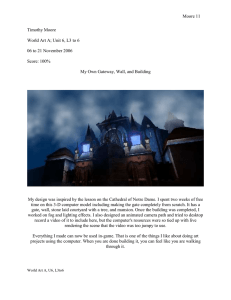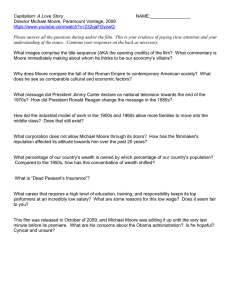Problem Set 2
advertisement
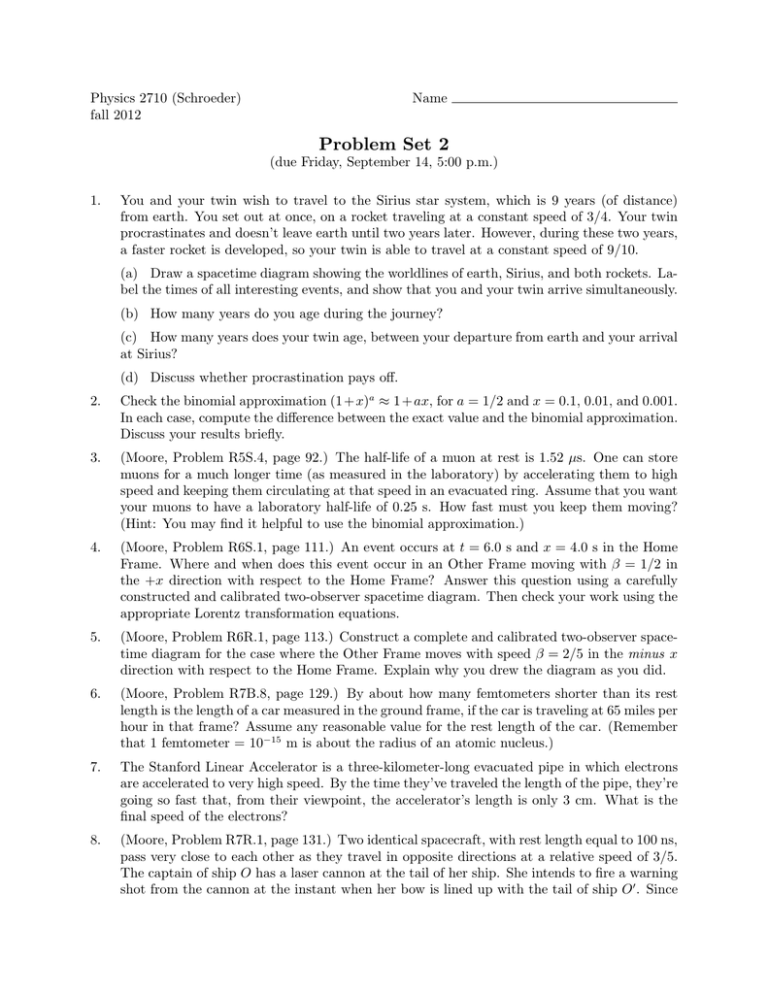
Physics 2710 (Schroeder) fall 2012 Name Problem Set 2 (due Friday, September 14, 5:00 p.m.) 1. You and your twin wish to travel to the Sirius star system, which is 9 years (of distance) from earth. You set out at once, on a rocket traveling at a constant speed of 3/4. Your twin procrastinates and doesn’t leave earth until two years later. However, during these two years, a faster rocket is developed, so your twin is able to travel at a constant speed of 9/10. (a) Draw a spacetime diagram showing the worldlines of earth, Sirius, and both rockets. Label the times of all interesting events, and show that you and your twin arrive simultaneously. (b) How many years do you age during the journey? (c) How many years does your twin age, between your departure from earth and your arrival at Sirius? (d) Discuss whether procrastination pays o↵. 2. Check the binomial approximation (1+x)a ⇡ 1+ax, for a = 1/2 and x = 0.1, 0.01, and 0.001. In each case, compute the di↵erence between the exact value and the binomial approximation. Discuss your results briefly. 3. (Moore, Problem R5S.4, page 92.) The half-life of a muon at rest is 1.52 µs. One can store muons for a much longer time (as measured in the laboratory) by accelerating them to high speed and keeping them circulating at that speed in an evacuated ring. Assume that you want your muons to have a laboratory half-life of 0.25 s. How fast must you keep them moving? (Hint: You may find it helpful to use the binomial approximation.) 4. (Moore, Problem R6S.1, page 111.) An event occurs at t = 6.0 s and x = 4.0 s in the Home Frame. Where and when does this event occur in an Other Frame moving with = 1/2 in the +x direction with respect to the Home Frame? Answer this question using a carefully constructed and calibrated two-observer spacetime diagram. Then check your work using the appropriate Lorentz transformation equations. 5. (Moore, Problem R6R.1, page 113.) Construct a complete and calibrated two-observer spacetime diagram for the case where the Other Frame moves with speed = 2/5 in the minus x direction with respect to the Home Frame. Explain why you drew the diagram as you did. 6. (Moore, Problem R7B.8, page 129.) By about how many femtometers shorter than its rest length is the length of a car measured in the ground frame, if the car is traveling at 65 miles per hour in that frame? Assume any reasonable value for the rest length of the car. (Remember that 1 femtometer = 10 15 m is about the radius of an atomic nucleus.) 7. The Stanford Linear Accelerator is a three-kilometer-long evacuated pipe in which electrons are accelerated to very high speed. By the time they’ve traveled the length of the pipe, they’re going so fast that, from their viewpoint, the accelerator’s length is only 3 cm. What is the final speed of the electrons? 8. (Moore, Problem R7R.1, page 131.) Two identical spacecraft, with rest length equal to 100 ns, pass very close to each other as they travel in opposite directions at a relative speed of 3/5. The captain of ship O has a laser cannon at the tail of her ship. She intends to fire a warning shot from the cannon at the instant when her bow is lined up with the tail of ship O0 . Since ship O0 is length-contracted to 80 ns in O’s reference frame, she expects the laser burst to miss the other by 20 ns, as shown in the figure at left. However, to observers on O0 , it is ship O that is length-contracted to 80 ns. Therefore, these observers conclude that the laser burst will strike ship O0 about 20 ns behind the bow, with disasterous consequences (see the figure at right). Of course, the laser cannon burst cannot miss in one reference frame and hit in the other; this apparent contradiction is known as the “spacewar paradox.” O' O' O View from O frame O View from O' frame (a) Construct a carefully calibrated two-observer spacetime diagram of the situation just described. Define event A to be the coincidence of the bow of ship O with the tail of ship O0 , and event B to be the firing of the laser cannon. Choose event A to define the origin of both reference frames, and locate event B according to the description of the captain’s intentions above. When and where does this event occur as measured in the O0 frame? (b) Verify the coordinates of event B using the Lorentz transformation equations. (c) Write a short paragraph describing whether the cannon burst really hits or not. Discuss the hidden assumption in the statement of the apparent paradox, and point out how one of the drawings shown above is misleading. 9. (Moore, Problem R8B.1, page 148.) At 11:00:00 a.m., a boiler explodes in Brigham City (call this event B). At 11:00:00.0003 a.m., a shudder is felt (call this event S) in Spanish Fork, 150 km south of Brigham City. (Both times are as measured in the reference frame of the earth.) (a) What is the time between these two events in microseconds? (b) What is the distance from Brigham City to Spanish Fork in microseconds? (c) Plot these events on a spacetime diagram. (d) An alien spaceship cruising southward measures events B and S to occur at the same time. What is the speed of the spaceship with respect to the earth? (e) Why is it impossible for event B to have caused event S? (Please explain directly in terms of causality, not by invoking the impossibility of faster than light travel.) 10. (Moore, Problem R8T.2, page 147.) Plot the following events on a spacetime diagram, where for each, the first coordinate is t and the second coordinate is x, both measured in seconds. A = (1, 1); B = (4, 2); C = (2, 4); D = (3, 5); E = (3, 1). Which of these events could cause which others? List all possible causally related pairs, and explain briefly. 11. (Moore, Problem R8B.3, page 148.) Starting from the velocity transformation equation vx = ( + vx0 )/(1 + vx0 ), solve for vx0 in terms of and vx . Also explain how you could have guessed the result. 12. (Moore, Problem R8B.5, page 149.) Rocket A travels to the right and rocket B to the left, at speeds 3/5 and 4/5, respectively, with respect to the earth. What is the speed of one rocket with respect to the other? Answer this question using a carefully constructed two-observer spacetime diagram, then check your answer using the velocity transformation equation.
